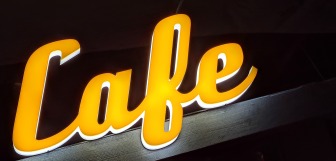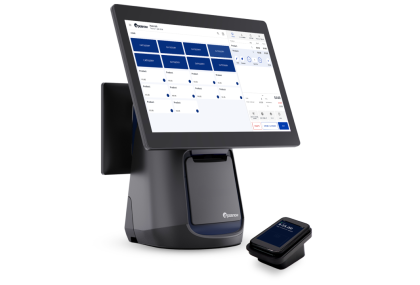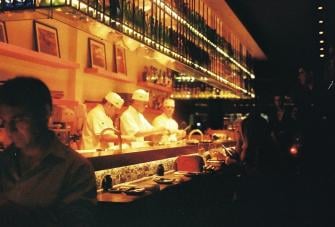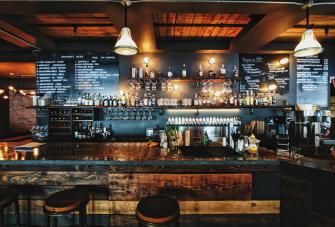Restaurant Branding: The Complete Guide
In the saturated restaurant industry, standing out from the crowd and attracting customers takes a lot of planning, hard work, and clever strategy. A business needs strong branding for lasting success and a solid customer base.
A restaurant brand does much more than advertise your business: it tells customers who you are and what you do, and once your brand voice becomes recognizable, it tells them your business is respectable and cares about the same things they do. Your brand is your reputation. So how do you look after your restaurant branding?
What is a brand?
A brand is how you want your customers to feel when interacting with your business. It is the profound, visceral reaction that people have when they see your logo, step into your store, and interact with your products and services.
Think about the brands that people know and love. When people think about Apple, they're inspired by ideas of creativity, individuality, divergent thinking, and beautiful design. When people think of McDonald's, quick, convenient, and tasty food comes to mind. For many, there is a hint of nostalgia from the restaurant's association with the heyday of the American fast-food chains of the 1950s and 60s.
Don't be scared to show who you are
It's no accident that people make build similar ideas about businesses. They work hard to cultivate brand personality because they know the benefits of good branding.
If you want your restaurant to stand out from the crowd, then developing a recognizable brand is one of the best ways. Some studies have shown that companies that have strong, discernable brands have some of the highest customer retention rates. This is particularly relevant for industries that have very high failure rate [1].
Write a mission statement for your restaurant brand inspiration
Many new businesses are started fuelled by passion and clear beliefs, shaping the beginnings of a brand identity by identifying what will be different about the enterprise. In recent years, it has become common to see businesses publishing their mission statements or goals online, on menus, or the walls of their premises so staff and customers alike can see their core values.
Jacyn Heavens, CEO of Epos Now, wrote the company mission statement over a decade ago, and it remains visible online even now. On that page, he's quoted as saying:
"I started Epos Now because I was a frustrated business owner. It's just not enough for POS systems to accept transactions, print receipts, create poor reports and yet be ludicrously expensive.
“It should be affordable, make your life easier, your customers happier and be accessible from anywhere."
Epos Now's mission statement both asks and answers critical questions every business needs to consider to build brand identity.
What questions do you need to answer in your mission statement?
- What are your goals? Identifying and publicizing your intentions for the business informs consumers which direction you hope to move your restaurant in. If you state that you want to provide affordable food on every street corner, they will expect to see more branches pop up around town and might one day see your franchise. Jacyn Heavens intended Epos Now to fill a gap he saw in the POS market, intending from the start to expand the capabilities of the Epos Now POS to make users' professional lives more manageable, and the business has continued to work towards that goal.
- Why those goals? It's no use having goals if they serve no purpose. Jacyn Heavens wants to help businesses achieve their own goals and "help businesses of all sizes reach their full potential through the power of cloud technology." Thinking about a unique selling point (USP) can help stress the difference between your business and all others. Is there a special kind of food you want to help people appreciate? Do you want to provide a world-beating dining experience? Why do you want your business to achieve its goals?
- What do you offer? If you've answered questions 1 and 2, figuring out what you'll offer consumers shouldn't be too difficult. Suppose your restaurant's mission statement provides goals of providing outstanding specialist cuisine and a relaxed experience. In that case, your restaurant's mission will be to offer the best traditional dishes from your cuisine in a serene environment. Your goals should direct the experience you provide to your customers.
- Who are you? The name of your restaurant provides potential customers with a key to the other questions. Your customers will learn this before they know anything else about you. Your restaurant logo plays a similar role in your first impression. Name your business and design your logo with those questions in mind.
Brand with your values in mind
Today, people want to do business with companies that are more than just purveyors of products and services. They want to do business with companies that stand for something [2]. You can read about this in our How to Attract Customers blog.
Your restaurant brand identity is intrinsically linked with your values. If you've decided that your restaurant will promote healthy eating, then unhealthy ingredients have no place in your kitchen. Your menu, recipes, and cooking methods should all reflect this commitment to providing healthy food.
The same goes for any other value you might want to instill in your restaurant. If you're passionate about sustainability, ensure that the fish on your menu comes from sustainable fisheries and that the beef is certified organic. Let your customers know where their food came from and how it got to their plates. This means sourcing ingredients from more expensive suppliers; however, your customer base will know and expect to pay for that sustainability, so that extra expense will quickly become part of the prestige of your brand.
The link between customer and business values demonstrates the importance of staying true to branding and marketing your business based on a clear restaurant concept and mission statement. Staying true to your core values will help you cultivate stronger brand loyalty in the long term.
Distinguish your restaurant brand from the competition
If you go for a walk in your area, the odds are you'll recognize many restaurant brands, some local, some nationwide, and some beyond. Many of these restaurants will be targeting a similar consumer to yourself. When you have your moment of restaurant brand inspiration, you'll need to identify an idea that will set your business apart.
This is called positioning - you need to place your brand within the market to connect with a defined audience and stand out from your competitors. Positioning yourself correctly in the market also allows you to communicate your value more effectively to your customers. Brand positioning means figuring out:
- Products: What are you planning to sell, and why should people choose it over the competition?
- Placement: Where are you going to sell? How can you reach potential customers most effectively?
- Price: How will you price your products and services? How do these prices compare to the competition? Are you providing value?
- Promotions: How will you promote yourself to your potential customers? What messaging do you want your marketing materials to send?
Research what might work
Conducting market research is essential when deciding how to position your brand. What else is out there in your local area? What products can you sell that will appeal to your target market? Are those other businesses already selling them? In which case, what are they not doing that you could incorporate into your service?
It might be that you can sell a similar service to a competitor at a lower price. You could provide a similar service with a more extravagant, fun service that encourages people to come to your establishment rather than another brand. What does your restaurant competitor analysis tell you about what opportunities you have for a successful business model?
Develop your brand voice
Developing a brand voice means humanizing your business. Determining how your company speaks and acts allows it to create a personality as such. You should discern the brand voice of your business to figure out how to communicate with the public.
Your brand voice will be the vessel through which you develop your restaurant brand. Your marketing efforts, the style you write your menus, and the tone you train your staff to communicate will all contribute to this voice.
Keeping your brand voice in line with your brand means ensuring they fit together. A traditional silver-service restaurant wouldn't suit menus full of playfully named dishes, posters with puns, or casual servers. However, that voice would suit more typically relaxed restaurants, such as pizza houses, diners, or bars.
Highlight brand elements that make you different
Restaurant branding distinguishes itself when it highlights or showcases something audiences feel they haven't seen before.
This difference doesn't have to be much. It could even be the aesthetic choices you make. Starbucks' logo design, which uses a mythological siren, has effectively tied its brand that stands for class, mystique, and glamour. The crown on the siren’s head gives Starbucks a regal air suggesting that they are the top chain (though this certainly wasn't the case when they first used the logo).
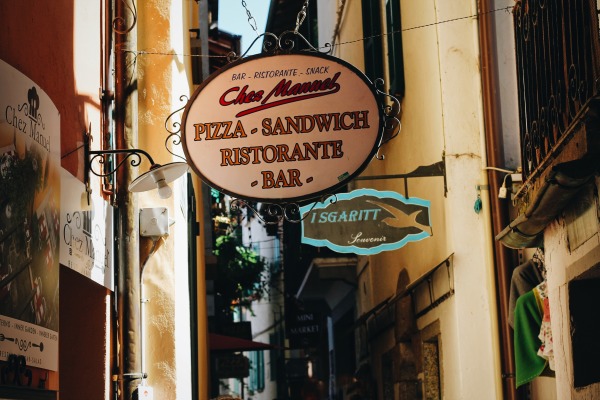
But restaurants have innumerable other options to focus marketing and branding efforts. If you designed your mission statement, you'd likely have a USP in mind already. Your restaurant concept may make you a one-of-a-kind, especially in your area.
If you're taking your business branding in a more traditional direction, your restaurant branding team still has plenty of options. Using your location to your advantage could make your USP the opportunity to eat with a unique view, or the chance to have great food in a great place.
Settle on a restaurant logo
Your logo is one of the most visible and vital aspects of restaurant branding because it will be seen on all marketing materials, from menus to websites. It should be unique and recognizable and must be able to work in a variety of contexts.
Here are a few restaurant logo design tips:
- Keep it simple, but look to make a lasting impression.
- Use strong and bold brand colors that you plan to use on-site.
- Use easy-to-read fonts.
- Think about any symbols you use, but avoid clichés
- Make sure it scales well.
- Think about how it will be used with other materials and in different contexts.
When creating a restaurant logo, less is more. A simple logo that is easy to read and remember will be much more effective than a busy and complicated one. And because you use your restaurant logo in various contexts, from website headers to receipts to the restaurant's menu, it's essential to make sure that the logo looks just as good at small sizes as it does at large ones.
When it comes down to it, restaurant branding is all about creating a unique identity for your restaurant that will appeal to your target audience. By settling on a solid logo and using it consistently across all marketing materials, you can build a recognizable brand that will attract new customers and create loyalty among existing ones. And with a bit of creativity and effort, you can make your restaurant's logo truly one of a kind.
Dedicate some time to your restaurant’s design
Just as important as the design of your logo is the restaurant’s interior design. The furniture, colors, signage, and fixtures you choose for your restaurant should all work together with your brand’s values and mission statement and reflect your brand identity.
If we take the example of a vegan restaurant, that restaurant will want to use materials, colors, and decorations that suit its brand. So, they might choose a minimalist design scheme to emphasize the restaurant's branding as simple, natural, and relaxed. They might choose earthy, muted tones to reflect their emphasis on buying clean, organic produce. And they might choose a bichrome menu design that’s simplistic and functional.
Think about how you can reflect your brand’s personality in your restaurant’s design to attract customers that share your values.
Choose which platforms suit your voice
When you go in search of restaurant branding ideas, it also helps to think about where each element of your marketing is going to go. Your restaurant's success depends on your marketing, and a lot of what you create will need to be specific to the platform it's used in.
Though many of your aesthetic choices will remain the same, such as your logos, color palette, and font choices, the length of the content itself, the audience, and the space you have to connect people to the business will vary greatly.
The digital age gives restauranteurs more opportunities than ever to market their businesses. So choosing which avenues to explore (or specific ones not to invest in) is a big decision, especially as it may influence which channels you can sell on.
For instance, building a restaurant website will require investment but will make reaching new customers and selling takeaway or delivery easier and cheaper. This may be essential if you're targeting younger audiences, as young people spend more time online than other demographics.
Potential brand-building avenues
- Social media platforms (Facebook, Instagram, Twitter): Which social media platforms will you commit to? What kind of posts would suit your brand? You might suit professional posts about events, special dishes, and new products alongside testimonials from guests. Or you could have a personality-led profile about jokey staff members having a good time at work.
- Email marketing: Email marketing comes in many forms and can be a valuable part of the customer experience and relationship management. This might come in the form of an industry-focused newsletter, a light "what's on" list, or could be a more personal collection of updates on staff, product, and development news. Each would suit different kinds of brands.
- Blogs: Similar to the customer newsletter, blogging can maintain relationships with customers even if they haven't been in recently, thus contributing to customer retention like a few other strategies. Blogs can be as varied as newsletters but do not require consent from customers as they are not sent directly to customers. Consequently, they can also get new customers coming in after discovering you through your blog.
- Physical advertising: Having a sign in the local area can make your business more familiar to locals and can attach the brand to the local community in a very noticeable way. On the other hand, leafleting can help target areas where your target audience may be based and provide creative freedom to express what your business is really about.
- Local media appearances: Though it may take some courage, an appearance on a local radio station could contribute to restaurant branding in a unique way, building links to your local community. Much like signage, radio appearances give you a platform to build a restaurant brand linked to the local community. For some brands, especially those more traditional or rural, this can be an invaluable part of your brand's personality.
Almost ready to trade: don't forget your POS!
Entrepreneurs build all restaurant brands on the solid foundations of reliable service, smooth selling, and efficient administration. Nothing provides that better than an integrated POS system. Epos Now technology provides new SMEs with all the tools they need to grow into world-renowned brands.
- Streamline your sales process with fantastic transaction software and an all-in-one POS and card processing kit.
- Manage cross-channel products and inventory, and view reports on-site or off using cloud technology.
- Increase security and simplify sales for new starters with staff access controls and multiple access levels for a system that suits your needs.
- Make better business decisions using hundreds of downloadable reports and integrations from the Appstore for accounting, marketing, online ordering, and more.
To find out more about a restaurant system with every tool you need to build a fantastic restaurant brand, submit your information below and speak to a member of our expert team.
Choose a POS trusted by 40,000 businesses and the very best restaurants

